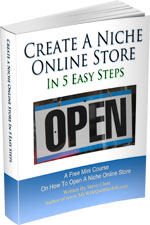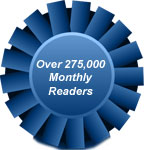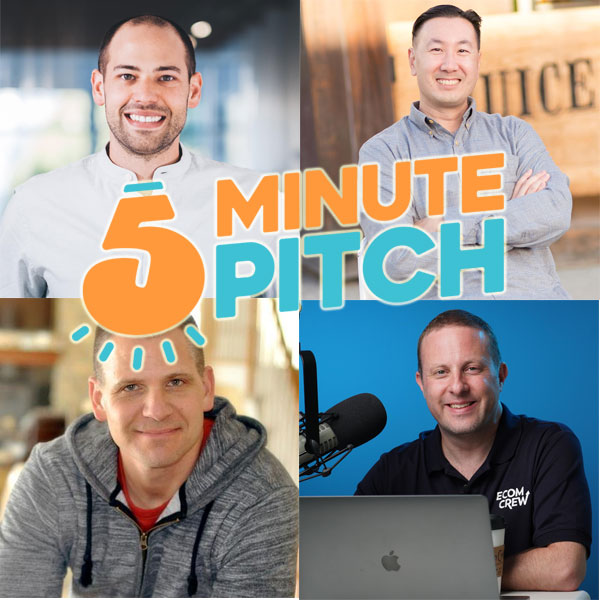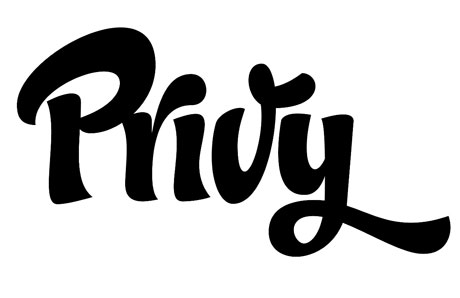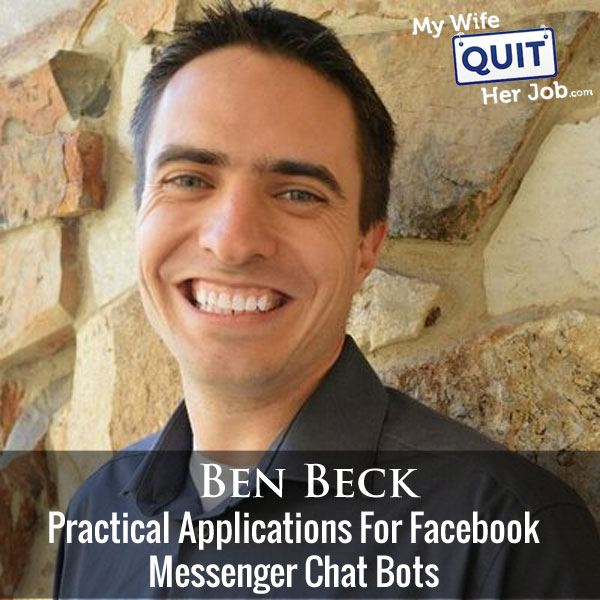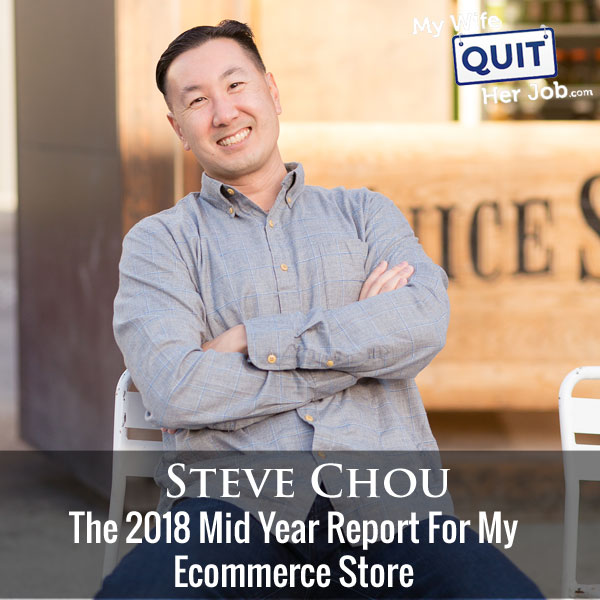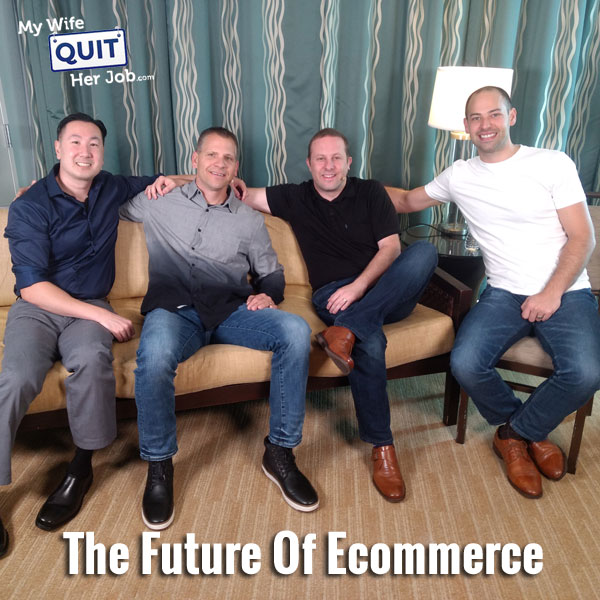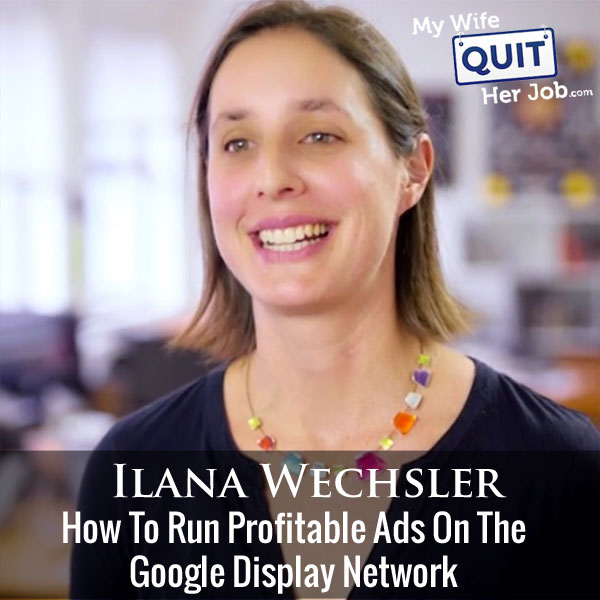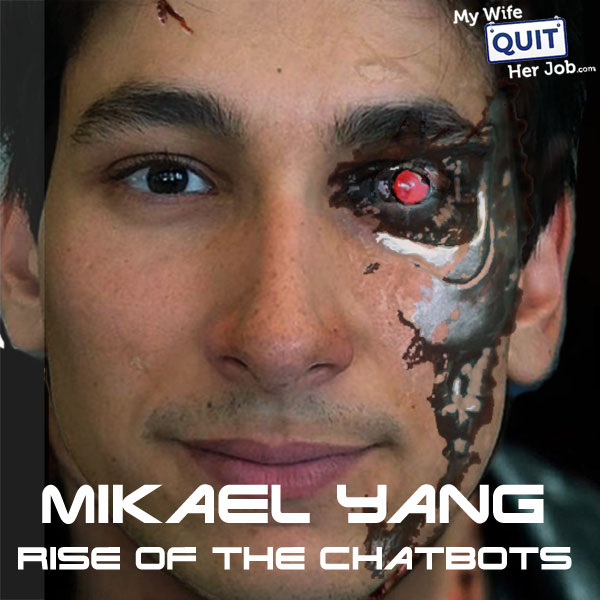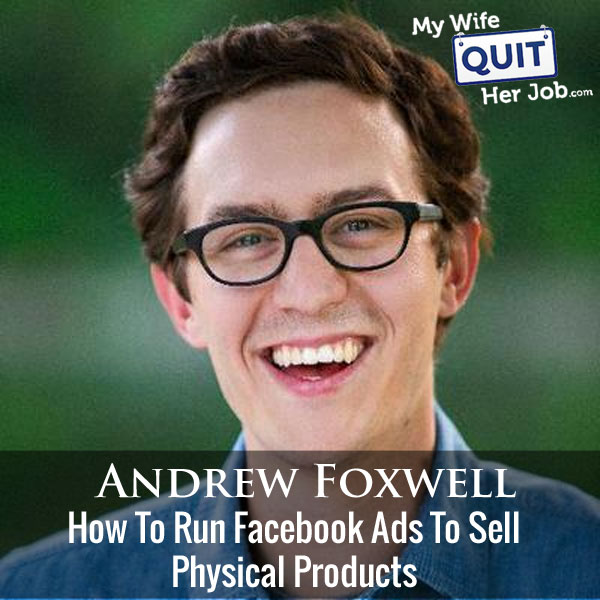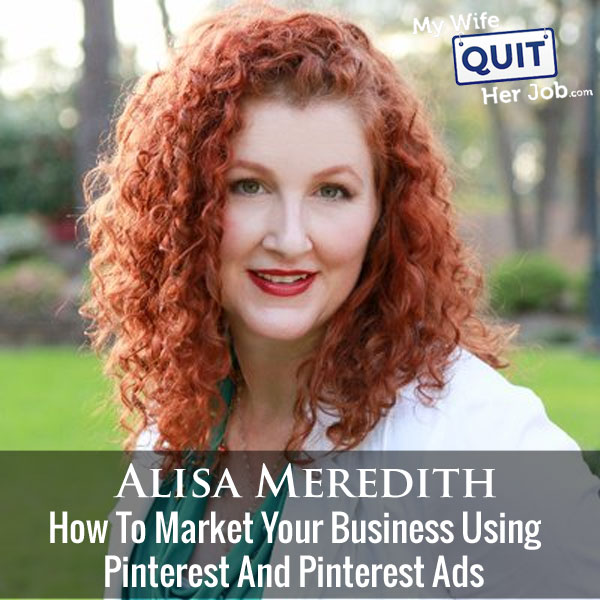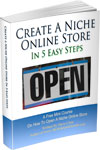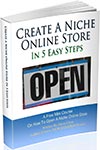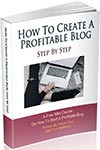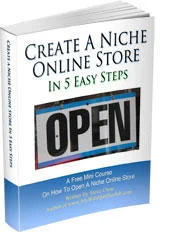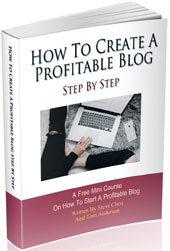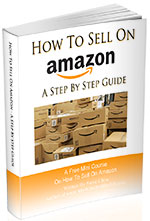In this episode, Scott Voelker of The Amazing Seller, Greg Mercer of Jungle Scout, Mike Jackness of EcomCrew and I get together to discuss the future of ecommerce.
I’m also happy to announce that the 4 of us have decided to launch a brand new show together called The 5 Minute Pitch. Basically, it’s a Shark Tank like show where we’ll be giving away $50,000 dollars to 1 lucky business.
Steve: You’re listening to the My Wife Quit Her Job Podcast, the place where I bring on successful bootstrapped business owners and dig deep into what strategies they use to grow their businesses. Now, today, I have an extra special episode for you. Instead of the usual where I interview a single guest, I decided to bring my good friend Scott Voelker of the Amazing Seller, Greg Mercer of Jungle Scout, Mike Jackness of EcomCrew, and my partner Toni Anderson on the show.
Now, this podcast was actually a live Q&A session that we held last week where all of us answered questions about the future of e-commerce. So for example, we discuss how to deal with the Chinese competition. We talk about the tariffs, and how they will affect sourcing costs, we talk about finding products to sell; basically we cover a lot of ground here in one action packed hour. Now what’s also cool about this episode is that I’m happy to announce that Greg, Scott, Mike, and I are launching a brand new show together called the 5 Minute Pitch.
Basically, it’s going to be a Shark Tank like show where we’re giving away $50,000 to one lucky entrepreneur. 32 companies will be selected to pitch Greg, Scott, Mike, and I, and the winner will be selected on a live show with all of us. It’s going to be an awesome show and we’re going to start filming in September. If you’re interested in submitting your business, head on over to 5minutepitch.com, that’s the number 5-M-I-N-U-T-E-P-I-T-C-H.COM, now on to the show.
Intro: Welcome to the My Wife Quit Her Job Podcast where we’ll teach you how to create a business that suits your lifestyle so you can spend more time with your family and focus on doing the things that you love. Here’s your host Steve Chou.
Toni: Hey everybody, it’s Toni Anderson from Sellers Summit and I’m excited today to be with some of my absolutely favorite e-commerce people and faces you probably recognize if you’ve been to any of our Sellers Summits. In fact I think everybody who’s on today is a three times Sellers Summit alumni, right guys?
All: Yeah.
Toni: Yeah. So joining us today to discuss some of your favorite e-commerce topics that you’ve submitted, we have, let me go left to right. So I think Greg is first with his fancy elevator background which…
Greg: Thank you for having me on.
Toni: So yeah Greg, CEO of Jungle Scout. I think you’re probably known him best from that. He’s doing a lot of things; he’s got a new podcast out too. Next we have Steve Chu who you guys are probably pretty familiar with, I won’t even bother with more of an introduction, but he’s a big deal. And then we have Scott Voelker who — I know.
Steve: I don’t have an elevator that goes to my private floor however.
Toni: Exactly. Scott Voelker from the Amazing Seller and everybody is really familiar with Scott, our three times speaker at Sellers Summit. And then Mike Jackness, mentor, seller extraordinaire from the EcomCrew Podcast, and probably more famously of ColorIt I think, I don’t know which is bigger now, but they’re probably equal. So these guys are here today to answer some of your questions and talk about e-commerce. Hey, guys.
Scott: What’s up Toni?
Greg: Hello, excited to be here?
Toni: Yeah. So we’re going to just kick off right away with some questions. That’s the best way you think?
Steve: Yeah, let’s do it.
Toni: All right. Okay. First question and this is for anybody who wants to answer. It says, with the dominance of Chinese sellers at Amazon for someone just starting out, would you recommend starting on Amazon, or avoiding it completely and just going with your own website?
Steve: I wonder what Greg is going to say here.
Greg: [inaudible 00:03:25] through that first question. So yeah, I’ll go ahead and take this one to start. There’s going to be mixed opinions with the different speakers here. Me personally, I’m under the belief — I think I’m the minority here that like to me everything about Amazon is just so much easier, regardless of how many of the Chinese suppliers are trying to go direct there. And when you really factor into the time that you spend on doing everything, whether driving traffic to your site, building your own e-commerce sites, whatever else that that time and effort and brainpower is best spent on Amazon. But let’s hear some of the other guys’ opinions because I know you have conflicting views.
Scott: I think for me personally, like I would say, and I’m still like advising like people launch on Amazon. But I think it also — you have that additional channel that’s being built alongside. I think like Greg said, I mean, the traffic’s there, everything is built, like, all you really need to do is kind of like set up your listing, and optimize and all that stuff. But in the same token, if that’s all you do, and you don’t give yourself the outside channels, or the assets to drive traffic, and even push the algorithm, or just take your traffic and direct it wherever you want, I think it’s risky.
And I think then you could have a product that’s doing well with 1,000 units and then all of a sudden, a Chinese seller comes in, hijacks whatever, and all of a sudden, you’re fighting that and you might be on to your next product, I would rather have the ability to be able to take that traffic and direct it to where I want. So that’s where I’m kind of leaning. And that’s where I’m advising other people to do. But I think for launching, we’re always launching on Amazon, like, first. That’s kind of how we’re doing it.
Mike: Yeah, so for me, I mean I agree with all these guys. I mean, I think that until you have a business that’s large enough to start diversifying that you should just be on Amazon 100%. I mean, for me, it’s a million or 2 million, whatever that number is. I mean, Amazon is where 50 something percent of all e-commerce searches start. So it has a tremendous amount of built in traffic. And if you’re a solopreneur like just getting started, like trying to do all the other things to manage a business that is required when you have your own store, I think it is overwhelming.
But you also still need outside traffic sources I think to — if you look at what’s the future of Amazon, I think outside traffic sources, your own list and ways to dictate where that traffic’s going whether it’s to Amazon or not, is going to be really important. And I think the other thing that’s important when it comes to the Chinese sellers thing specifically, is not to develop like exact me too products. If you work more on a brand then a look and feel and improve upon products and make them your own, add functionality or do something different so it’s not like the exact same product that 10 other people have up there, I think, is how to win in the future on Amazon over the next couple of years.
Steve: So I actually agree with Scott and Mike and to a certain extent Greg. I don’t have that much to add, except for the fact that the way I’ve been advising people these days, is to start out on an Amazon for sure. It’s an easy way to get quick wins, get sales. And then once you know that you’re going to stick with that product line or that brand, then start your own website and start building up a list, start building up assets, because it’s really hard to establish a brand on Amazon that’s memorable.
To this day my mom still thinks that when she shops on Amazon, she’s buying from Amazon. She doesn’t even notice the brand star per se. And again, it depends on your product. You need to be able to differentiate your product in order to succeed these days. Don’t tell me too products, like Mike said.
Toni: All right. Well, staying on the Amazon thread and this is a real beginner question and I think you guys probably have some good advice for this. But if you want to get started on Amazon, do you recommend a course or video that people should be using as a resource? Steve you got anything?
Steve: Actually, we all have our courses [overlapping 00:07:27]. We all have stuff now. Greg’s stuff is free I want to say. So like, you don’t want to pay any money. Actually, we all have free stuff. Actually, we all have free stuff. Just go on all the websites, I’ll go ahead and link all that stuff up in the membership site. And you can just go and take all of our free stuff and then decide for yourself. I think that’s the best way to do it.
Toni: I think too, if you have a virtual pass which you do if you’re watching this, there’s a lot of sessions from this year’s summit that will help you get started on Amazon as well.
Steve: Yeah, we all have different styles too and that’ll really come through as soon as you start looking at some of the free stuff. And so you just want to gel with the person’s philosophy that most resonates with you.
Toni: Yeah, but everybody’s got a ton of free stuff. So, definitely grab that stuff first, and see who you connect with the best I think would be my — since you didn’t ask me, I’ll say that. Okay, let’s see what else? Okay, so this is one a little bit off Amazon. What is the best way to get traffic to your brand, Facebook, Instagram? Would you start with paid advertising? What are your recommendations?
Mike: So it’s probably going to be market dependent. So I think that the younger the crowd probably more leans towards Instagram and orders leaning towards Facebook. Women seem to lean towards Pinterest or Instagram more heavily as well, versus men, just from what we see. We run three different brands. So like, for instance, Tactical and ColorIt do really well with Facebook and WildBaby does better with Instagram.
I think that starting with paid traffic is probably the way to go because if I guess the alternative that you’re asking about would be organic traffic or SEO which takes 18 months to really ramp up. So, if you need quick wins, faster revenue in the door, faster fetcher your motto or your goal before right now then I would work on getting good at pay traffic, because you can get basically instant wins with that once you get over the learning curve.
Steve: A common question I get asked is why don’t you just start with Google or Facebook? So, first of, I just want to say that when you’re starting out, you should probably just choose one and become really good at that one channel instead of just trying a whole bunch of different things and failing at everything. That’s just a common thing that I tend to see, they try something once, it doesn’t work, then they give up. So, you want to choose one of the other. Google and Facebook are the largest players and it just really depends.
So, if people are out there searching for the thing that you want to sell, then Google will tend to work well. But if people aren’t actively searching for what you had to sell, then Facebook will tend to work better. And Google in my experience that we run Google ads and Facebook ads, and our Google ads are actually very profitable. But it really depends; Google tends to be a lot more expensive. And the way you want to start out with Google is you want to probably just start out with retargeting and just trying to get people that have already been to your site. And if you have to choose the different Google flavors to start with, I would start with Google Shopping.
And the main reason for that is you have an image, and you have the price. And so when someone clicks on the ad, there is a much higher probability of them actually having the intent to buy a product, and of course there’s Facebook ads. I think Facebook ads; the interface is a whole lot easier. And again, if you’re just trying to get leads or if you’re just trying to get some traffic to your site, then Facebook ads tends to work really well. And as Mike said, it really depends on your demographic.
For our demographic which tends to be older people, a lot of older people are on Facebook, including myself, and my mom and sister, those platforms tend to work well. Google I found is just really expensive and you have to spend a lot of money to kind of train Google to understand where your conversions are coming from, and only then will your prices start to come down.
Scott: And the only thing I want to add to that is it’s one thing to grab traffic from the paid side of things. But I think the really important part is, and I think Mike talked about that a little bit is like, understanding who it is you’re targeting, and trying to get really focused on that. And if you do have your own web property, to instantly put a pixel on that page, so you can start to build that custom audience as soon as possible. That’s with Facebook that is because we can get traffic pretty much on any platform. But if we have the right traffic, that can be a big difference between converting and not converting.
And then also knowing where to send them, whether it’s your own website, or if you’re going to do a coupon, let’s say, for an Amazon thing I would always intercept that with an email address in exchange for the coupon code. So I have that opportunity later to be able to target them and they also raised their hand. So, that’s the only thing I wanted to add, just make sure that you understand who you’re targeting.
Steve: I also want to add that you don’t want to be driving traffic to your site unless you have a way to retain them. So these days, it takes up to like eight touch points before someone is going to buy. And so you have to have things in place to bring people back to your site, either through email, through messenger, through pixel and retargeting ads, you have to have all that stuff in place, so that you’re maximizing the traffic you are paying to get to your site.
Mike: One other thing I want to mention about Facebook ads I forgot to mention earlier, Facebook ads are very dependent on the type, but I already mentioned the type of demographic, but also the type of product. So, Facebook ads work way better if you have an audience that’s aligned with your product. So as a for instance, there’s an interest group on Facebook of people who like coloring.
So it’s very easy for us to target people for that. We have the Tactical brand. It’s very easy to target people who like camping, or hunting or fishing. The example I always give for IceWraps is it’s hard to target someone who has aches and pains because that’s not an interest on Facebook. So, it’s also very product dependent. And some things just do not and will not work well on Facebook because of that.
Steve: Someone just asked in the live chat. I thought I just answer this real quick. Do you have any advice for tricks on configuring an email campaign to minimize the chances of those emails going to the dreaded promotions tab? In our experience, even pure text emails end up being flagged as marketing emails? Yeah, the way you get out of the promotions tab, so there’s one way that when someone signs up, you can actually give them a tutorial on how to drag that email out of promotions tab into the inbox so that you’re regarded as a safe sender. And then at that point, all of your email should go to their inbox.
If they don’t do that, well, then you actually have to send out good emails that people actually open. And over time, Google or Gmail will learn to not put that email in the promotions tab, because you’re actually engaging with the person they’re emailing. Any of you guys have anything to add about that?
Scott: Yeah, the only thing I want to add to that, I’m not sure if it’s 100% across the board. But what I’ve found, it seems to work is number one; we need them to open the email, right. And in order to get that first email open, we need it to end up not in their promotions tab. So, what we’ve played around with is not having anything promotional or anything that could flag it as spam. So the title could be like, thanks, or something very generic. And then inside of the email copy, again, no links, just maybe, hey, if you have any questions, let us know, reply, keeping it really lean. And then that will allow you to possibly get in the inbox. And then if they do open it and touch it, it also signals that they want to receive that email. Now, again, I’m not sure if that’s going to work across the board. But we’ve seen, we found that to work really well.
Steve: Actually, one thing that does work across the board is you say something in the first line, hit reply to this message and say, hey, and asking a question.
Scott: Yeah, that one works well, yeah, or just like, what do you think about this email, or what’s your favorite type or something else, and they respond to those, it helps train Gmail. But I would say, there’s also there’s no golden ticket for this, like, Google is very smart. I’m sure they’re using machine learning algorithms for this. Over time, they’re constantly changing it and everything else. I mean, if you’re sending emails that are very promotional in nature, it’s going to be like a constant battle that oval overtime and Google is usually probably going to win.
Mike: We use a program called GlockApps, G-L-O-C-K-A-P-P-S.com, and it allows you to send your emails to a bunch of seed addresses. And it’ll tell you if they’re going into the promotions tab, or the primary tub. And we’ve had really good luck basically doing that, and then refining the email over two or three, or sometimes 10 edits depending on what we’re doing. And it’s some of the things these guys have already mentioned, some of the wording and stuff is a lot of it, the number of links, if you have an image that needs to be compressed and be smaller, things of that nature.
And we’ve had really good luck getting emails from promotions to in the inbox by doing that, and that increases our open rates typically on those campaigns by like 50%. So instead of having a 20% open rate, we’ll see 30% open rates on ones that are in the inbox versus promotion.
Toni: All right. Well, speaking of tools, the next question that we have is how much software should I have in my business? It feels like I have too much, one for sales tax, one for inventory, accounting, it adds up to decent monthly expense, what do you guys recommend? Maybe keep using the software and focus on the 80/20 of my business?
Mike: The only tool that I have that I pay for is Jungle Scout.
Steve: I agree.
Greg: Catch you.
Mike: That’s the only one you need.
Greg: Everyone is always, and of course I’m open to software solutions so it’s rare to hear this from me. But like, everyone is always looking for like software platform, it has to be like magic bullets. Like what piece of software do I need? It’s like, well, like, what pain points do you have in your business? Are you having a really hard time managing your inventory? And so then that’s probably money well spent. So, I would say more so be thinking about like what kind of ROI are you getting from these and like what pain points do you really have, and then look for software to solve this particular one.
Mike: It’s hard to get by in this business without a whole bunch of different tools. And I think the person is probably coming from the same level of frustration that I have. I look at that line item on our PNL every month and it continues to get bigger and bigger because you’re right, you need now especially with this tax rolling that just came down, you need something like a tax jar of relearning, you need something like an inventory management software and a shipping software and accounting software and an email platform.
And next thing you know, you’re spending mid four figures or even getting to high five or four figures in just SaaS applications. And yeah, definitely eats into your bottom line. But there as Greg said, I mean, we look at the ROI of those. I mean, the ones that we continue to keep are ones that add some benefit to our business that more than pays for the cost of the subscription.
Steve: I think it’s just much harder to do this when you’re first starting out, right? You’re not making that much money, and then you having huge bills. And so…
Scott: I wouldn’t get them though at that point then, right? It’s like, I think you have to add as you need, right? If you want to free up — if you find yourself at the end of the tax season wondering, why you’re spending a week or two weeks trying to figure out where you are, and you don’t know where you are in your business, then you need an accounting solution, right? But I mean, probably should have that beforehand.
But like, yeah, there’s a lot of the bells and whistles out there I think are the ones that are like tools that are like, you’re going to find the ultimate like silver bullet like, no, like those I don’t think we do have to have, maybe you get it for a month, and then maybe you cancel it. But for the most part, you need the basic ones to run your business, but when you need them. I don’t think just because you have a business doesn’t mean you need to have an inventory solution when you don’t have a lot of product, right?
Steve: Yeah, I mean, I recommend starting out with the starter plan of the web app. And then as your business grows, then grow up, sign up for the professional Jungle Scout web app. Right, Greg? It does take a nice trajectory of growth as your business grows.
Greg: Yeah.
Toni: Steve, I know you don’t like to pay for anything.
Steve: Yes, I don’t. I’ll just take like one minute talking about my philosophy.
Toni: Yeah talk about your philosophy because I think it’s a little bit different than most people.
Steve: It is. So what I tell everyone to avoid is like paying for like stupid apps that don’t do very much that carry a monthly fee. There’s a bunch of these on Shopify, for example. I’ll just give you an example of something I just did last week. So there’s this program called Funnel, which is basically a countdown timer that you can create scarcity in whatever you’re trying to sell. And they wanted $80 a month for that.
And it took me two days to replicate that, and I just sat down and wrote that and then I saved $80 a month essentially. Now, and not all of you guys are probably developers, but a lot of these stupid things you can probably just hire someone to do and then you won’t have that cost forever. I don’t advise this for everyone, and thanks for bringing that up Toni.
Greg: I guess that’s one of the tricky things though like to me hearing that like, man, if I just spent two whole days to do something, it’s like man, I’d rather just spend the 80 bucks a month to solve that problem to save myself two days.
Steve: But I actually also enjoy doing that stuff too.
Scott: Let me ask you this Steve, do you like to go out to dinner or do you like to cook at home?
Steve: I prefer going out to eat.
Scott: And you’re willing to spend that money?
Steve: I am.
Scott: Even though you can go…
Steve: Well it depends…
Scott: I would have thought you would say, honey, we’re staying in tonight [overlapping 00:20:52].
Steve: …bill is ridiculous actually; we go out practically every single meal.
Mike: I mean, well, he’s told me probability is he prefers to go out because he doesn’t like Jen’s cooking. But…
Steve: No, I would never say that. I would never say that. We did have this, just like 30 seconds, we didn’t have this like Chinese chef that we used to hire to cook meals for us. So we had to go out, but her for food was just so terrible to the point like I used to dread coming home to eat. And then one time I actually got Chinese takeout and I ate it in front of her by accident. I wasn’t even thinking she was there cooking and I was even take out like Panda Express. So anyways, next question Toni.
Toni: A little Steve therapy session. Okay, here’s one for people who have a B2B business. It says what is the best thing I can do to drive traffic from my website, which is a B2B business, in your experience, does Facebook work well for this? And this, I think piggybacks a little bit on what Mike was saying earlier about you have to know your audience. So, if you have a B2B product, what’s the best solution for driving people to the website?
Mike: I can talk about the Facebook part specifically first. I mean, you can target things like job titles. So, depending on again, the type of product you have, you can target the procurement manager titles or things like that. It’s very tricky, though and it’s tough. And it really depends. It’s very, very product specific. We have some B2B component to our IceWraps business. And we’ve tinkered with this without a whole ton of luck. What has worked better is just as Steve was saying earlier, Google ads seemed to work better for these things. When people are actively looking for that product, you want to be in front of them.
So whatever, again that’s product specific. But if it’s something like custom gel ice packs, as a for instance, one of the things that we do that does really well for our B2B business, we just, we want to be ranking front and center when they’re searching for that, at that moment when they have that pain points. Facebook ad is still tougher, because they’re not looking forward at that moment. And for businesses, that type of marketing is much more difficult to kind of get over that hump than it is for an individual looking to buy something that’s more spontaneous. So again, it’s product specific. But businesses don’t typically spontaneously go out and buy a whole bunch of widgets.
Steve: I think an indirect way of doing it is to sell to the consumer and see who buys a lot of whatever you’re selling. And then reach out to those people or stock them, find out if they work for a larger Corporation, and then reach out to them and give them special coupon codes and special treatment. Like I went over this in my breakout session at the summit, but this is basically how we get B2B customers. As Mike was alluding to, on Facebook, we did try once a campaign because there’s, you can target like event planners and whatnot on Facebook. And we were trying to do that and our ad was basically giving out free samples of our napkins for these events.
And we ran it for a little bit and we had limited success, although I think we did get one or two customers. But as long as you just get like one or two of those guys who buy consistent from you, that can make your entire campaign worth it. But we weren’t getting that many bites because it’s hit or miss. They just happen — they have to be actively looking for whatever that product that you’re supplying is. And so that’s going to be hit or miss.
Toni: Anybody else got something to add? Scott’s nodding furiously, so I don’t know.
Scott: I was agreeing with him. I think all that’s a great idea, do it. But I think whenever you’re going to a B2B, it’s like you have to find either that purchasing person, right, or the person that’s supplying. If you’re selling like k cups for the office, it’s like you have to be able to target the person that’s making the purchases. And this is a little bit harder, but like Steve was saying, if you find even one or two, that can be well worth it, because it’s just kind of it’s like recurring revenue, you know? Yeah, I agree. I think that it’s all good stuff.
Steve: But one thing we used to do when we were really scrappy is we used to just cold call wedding planners and event planners and offer discounts. I think that will work better than Facebook ads, because you’re going through the — I don’t want to say Yellow Pages because that dates me, but you go out there and you find companies who might be interested in your stuff, and you just establish a conversation.
Mike: Hey, Scott, how have you been able to sell garlic presses to restaurants?
Scott: It’s been a challenge. But we’ve reached out to some of the top chefs in the market.
Toni: Waiting for your Gordon Ramsay partnership.
Scott: Yes, yes.
Toni: All right. Okay. So this is another one. I think this is basically if you already have, if you’re already selling, what is your mindset for trying new things or launching tests for new ideas? What parameters do you set for yourself regarding budget, test period, anything?
Steve: Is this for ads or for products?
Toni: Let us limit it to introduce new products.
Steve: New products.
Scott: Okay. But so it’s you’re talking about in the same brand though? We’re not talking about jumping to a different project.
Toni: Well, they weren’t specific.
Scott: Because that’s immediately what I started thinking about because as entrepreneurs we’re like, oh, wait a minute, there’s something we can do over there. If it’s in the brand itself, that’s different. And we can talk about that. But if it’s projects, like let’s start a new venture over here, I’d be careful on that.
Mike: If it’s within the same brand, like one of the best feelings in the world when you get to a certain point within your brand is to just be able to like send out an email and pull your current customers, and ask them what they want. It was like a wonderful, like year to 18 months for ColorIt and new products. We kind of got to a certain point, we had a core group of people, we sent out a poll, like what do you want the next book title to be, or next product? And we polled people with some multiple choice stuff, and also right in. And yeah, we didn’t have to come up with any ideas for a very long time after that. So that was a really good way.
Scott: Like, let me ask you, like so on that survey and stuff that you did, how many people do you do you think that you sent that to or that you didn’t send it to, how many responses? I think people would be interested to know that because some people think, well, I got it this massive list and this massive amount of people coming in and giving me this stuff. Like, where could — or when could someone start to do that?
Mike: We didn’t, we weren’t smart enough to figure out to do it until I think further than that we needed to. I think that if you got at least 1,000 people that have purchased from you, I think it’s probably a good barometer for that actual purchasers. I think it is probably a point where you can send it out and get not false positives, right. Because like, you can end up with like some variance issues where like if you’ve only had 100 customers, three people wanting something can really throw that off. But yeah, when you kind of get, I think a point where you have 1,000 or 2,000 people that have purchased from you.
We already had like over 10,000 customers by the time that we sent this poll out. And the thing that was interesting about it, we do a thing called ColorIt Live every week. And we’ve been doing now for a couple years. And we had a couple of people in the ColorIt Live every week asking for a ColorIt by number book. And this was actually when we decided to do the poll. And I was like, okay, well, we’re going to go out and do this ColorIt by numbers book. And in that smaller subsection of just a couple of hundred people a week that will come to ColorIt Live, it seemed like this was something that was like going to be really, really in high demand.
And then we did the poll, and it was literally the least ranked one. So like if you can get a larger group of people together. And that basically stopped us from doing a disaster because it would have been a much tougher project than our typical stuff. And those same couple of people still ask all the time, when are you coming out with a ColorIt by number book? We know that there just isn’t going to be any demand there for that. And the books that we did release because they were the one that, we ended up releasing first from that was the mythical and fantasy book that we do. And it’s still by far and away our best seller to date, because we polled our customers and we knew exactly what they were looking for.
Greg: Oh, I had something to that, since the question wasn’t too specific I’ll just talk real quick about kind of like my philosophy about too many projects as an entrepreneur. I think Scott started to allude on this a little bit about like always kind of chasing the next shiny object, and I’m super guilty of this. But like when I look back, kind of like throughout my career, I’d say like as an entrepreneurial, most of the biggest mistakes or little same mistakes that I’ve made is like trying to do too many like different things instead of like really doubling down on like what’s working.
It’s like when you find those one or like two marketing channels that work really well for you, don’t feel like you also need to be going out and doing Snapchat ads and this and that, the other thing. It’s really easy to do when you hear these things or you hear someone else is having successes, usually doubling down on what’s working for you is the better solution as opposed to always trying to do more and more and more and more.
Steve: A real question, a quick question on the live chat. Do you guys use brand ambassadors in your brands and how do you structure that? What are the requirements and benefits for a brand ambassador? Scott that’s you, right, or?
Mike: So marketing or are you talking about like an actual like…
Steve: Like over space in the company, I guess? Yeah.
Mike: Okay.
I wanted to take a minute to talk about a brand new show that Scott Volker of the Amazing Seller, Greg Mercer of Jungle Scout, Mike Jackness of the EcomCrew, and I are launching in the fall of 2018. It’s called the 5 Minute Pitch, and it’s a Shark Tank like show where we’ll be giving away $50,000 to one lucky business. 32 companies will be selected to pitch Greg, Scott, Mike, and I, and the winner will be selected on a live show with all of us. It’s going to be an awesome show and we’re going to start filming in September. If you are interested in submitting your business, head on over to 5minutepitch.com, that’s the number 5-M-I-N-U-T-E-P-I-T-C-H.com. Now back to the show.
Scott: Yeah, for the brand that we’re working with now, we do have a face. The question I get a lot of times, what if you don’t have a face? What do you do with that? I say, then you can find someone that could be the face. And I do think there’s a lot to it as far as giving you an advantage. Plus, that person is now kind of representing your brand and also people start to buy into that person. Obviously, it has to be a likable person, or it has to be someone like we were just talking before we even got on here about being animated, being excited, like those things play into that.
If he just came on here and go, hi welcome. I’m going to share with you how to press garlic today, like you need that. But I think it’s important if you can have it. I don’t think it’s a deal breaker if you can’t. And I think if you’re struggling with finding that ambassador, that someone that could be the face, then I say go out there and find someone that enjoys doing what — in your market, doing what it could be to help your market or like in ColorIt like color, right? Like finding someone that is that person and then offering either to pay them weekly to do an hour or two, or possibly even have them come in on the company with a small portion of the company depending. I think it’s a huge thing if you can find one.
Greg: I agree with Scott a lot on that, like people like purchasing from like other humans and people really enjoy like a little bit like behind the scenes like what’s going on in the company or who they’re purchasing from, or those types of things. They like want a much stronger connection, you’re kind of like building a tribe that’s like a fan of this. For example, like Mike Jackness, I don’t think I’ve seen like him all over the ColorIt stuff. But I have seen videos of like this other female personality. I don’t know if that’s a full time employee or what.
But I think like anyone could do this pretty much across any different type of company or product, but just giving like a little bit more like an inside look at what’s going on behind the co– on inside the company or kind of like who they’re buying from. It’s like they’re buying from a human instead of just this company object.
Steve: I think we can attribute the success of ColorIt to the fact that Mike is not the brand ambassador.
Scott: It’s true.
Mike: Actually I accept that’s true
Toni: Okay. While we’re speaking about personalities, we have a question for Scott. Steve and I actually got a little laugh out of this question earlier. Scott, you’re a pretty quiet and reserved in person, but your personality packs a punch during the recordings and videos, how do you make sure you’re engaging to listen to? I don’t, I don’t think you’re quiet and reserved in public.
Steve: I don’t either man.
Toni: We have to like mute your microphone in there.
Scott: Yeah, that’s a little odd but okay. Yeah, I’m not really sure. I think whenever the video is on I guess I get excited about what I’m talking about. And generally, in this case, it’s business. But I could be talking about I don’t know, if I’m into dirt bike riding, like I’m going to be excited about that. I think people have told me before like I could get excited about anything if I’m — and get people excited about it. But in person, I don’t know, I think I’m a little bit more laid back because — not laid back but I think because I want to listen to those people versus me just being like listen to me.
So when you’re there, it’s like a two way conversation versus here it’s kind of like you’re kind of filling in the voice. Now we have people on the panel here. So it’s a little bit easier. If you’re doing a one off podcast by yourself, you really got to keep it moving. And I don’t know, for me it’s hard to slow down. But if you have people that kind of interject the stuff it’s better. But I think also in person I like to try to listen to where they’re coming from. But yeah, I think, I don’t know, I do pushups and stuff before I get on and everything. I don’t, I don’t really. Hopefully that answered that question. Next question.
Toni: All right, all right. Okay speaking of podcasts, and I guess this is a question for everybody since you all have podcasts. What is your podcast system workflow?
Scott: Oh, I love one, go Steve.
Steve: Mine is really simple. I basically…
Scott: Pay for anything.
Steve: I don’t pay for anything, except for Libsyn. I use Libsyn to host my podcast. I use my podcast to meet people. So I’ll basically just reach out, I use a tool called Meetme.so which I am paying for by the way [inaudible 00:34:50]. And I basically just schedule people, I record it, and then I dump it in my Dropbox and I have an editor who edits everything and then puts it up on my site. And that’s, it’s pretty much good to go. I don’t know, you guys flow is probably similar, right?
Mike: That’s very similar, like for me when I started it, I knew that if it became a burden that I just won’t stick with it, like I had to make it as simple as possible. So, when I record a solo podcast, I just use, I think it’s the built in app QuickTime, or I think it’s QuickTime. Oh, yeah, QuickTime. And then I use Call Recorder if I’m recording somebody over Skype. And I just drop that on Dropbox and Abby, who takes care of it for us now, she’s a full time employee for us, but it’s a Filipino employee who makes like 700 bucks a month.
And so she’s doing everything for EcomCrew. But also one of things that she does is produce the podcast. So she’s putting on the bumpers and the commercial spots, and the intro and autro and like edits, and does all that. And it’s super easy for me. Like, typically, if it’s a 30 minute podcast, I’m spending 35 minutes of total time to do it.
Scott: Yeah, and I’ll just say mine in the beginning I was everything. I was doing you know, I was recording, editing, even trying to put show notes together, no transcripts, but then I started to see that it was becoming a burden. And also, I was saying like, okay, well, the podcast wasn’t making any money in the beginning. So once I started to make a little bit of money from the podcast, I reinvested that back into hiring someone to do show notes professionally at it, and then also do transcripts. And so now my workflow really, I guess my biggest thing is preparing it. I don’t prepare like long, but I like to prepare three or four episodes so I can knock the three or four episodes out.
Generally, Tuesday and Wednesdays are my planning and recording days. And then I’ll just record in GarageBand, I use GarageBand, and then from there export, and then I will take that file and drag it up into Dropbox. And then they know what to do with it from there. And they even post it on the blog and all that stuff. And now that I’ve added YouTube into it, I’ve got a whole another flow for that, which is becoming a little bit of a challenge but I’m figuring it out. But that’s pretty much the podcast is really planning, recording, and then uploading it. Once it’s set up, it’s kind of like Mike was saying, it’s just like you record and then you just add it to your Dropbox.
Mike: If you’re asking the question, you’re probably thinking of starting a podcast yourself. So, just one piece of advice with that is that probably for the first year or a year and a half, you’re going to be talking to yourself and your mom. It takes a long time to kind of get a following and traction and almost just like blogs, like almost everyone gives up within the first year because they don’t realize like how much work and dedication it does take to do it week in and week out. Or like Scott does like three or four days a week now or whatever, it’s not a small time commitment.
And typically, people just fizzle out, or you’re excited about it to start with, and then you just don’t see the results as Scott was saying. You don’t make any money from doing it to start with. So, don’t even bother getting started unless you really know that you’re going to continue with it.
Scott: Let me just add… Oh, sorry, Steve go ahead.
Steve: I was going to say, my mom still doesn’t listen to my podcast.
Scott: I just want to add one more thing and then Greg you chime in. It’s like I’m realizing that there’s people in the e-commerce space that could start a podcast. And to me, you could stand out because there’s not as many people doing podcasts as there is people doing YouTube. Now, YouTube is good, because it’s visual and if you have stuff to demonstrate, I think it’s great. And I think eventually, you can do both. But a podcast if you have something, I know Death Wish Coffee has their own podcast. Now, it’s not about drinking coffee. It’s basically an entertainment show. But it’s also they’re now sponsoring the show in a sense, right.
So, if you have a way to connect with your audience and you enjoy doing it, and show up at least once a week. Now, think about that once a week. I think everyone can do once a week, 52 weeks, I mean, 52 episodes. And even if you’re only getting 300 listens, or 500 listens, it’s still people that are connected to you. And I haven’t found anything as close as connecting with my podcast listeners even YouTube, because people actually listen longer, and they get to know, like, and trust you to me faster. And you can’t really fake that.
So anyway, I just want to kind of throw it out there. If you have an e-commerce brand and you’re thinking about it, like I say, do it and you can commit to once a week. I think it’s a great thing. And I think it’s underutilized right now.
Greg: The as far as workflow, it probably sounds kind of like a broken record there because I have someone else schedule it, I just shove to record, it gets dropped into a Google Drive folder, someone else edits it and posts it so not a lot of work Kind of like on my end. To kind of tag on to what Scott is saying though, I’ve had a little bit different results with like podcasts versus YouTube. The one really nice thing about YouTube is or the biggest downside to podcasting in my opinion is like the discoverability in the search functionality to it.
So, once you like really putting your time, like all these guys had, you’re in those top hundred spots, then all of a sudden you do get discovered, just like from people browsing iTunes, or whatever else or like recommendations, but there’s no good search engine inside, I’d like to find podcasts like there is YouTube, or there’s nothing close to as good as what YouTube is. So I’d actually, if you were just starting out in my opinion, I’d probably actually be more interested in starting a YouTube channel targeting keywords that I know people are searching for to start to build up that audience a little bit faster. But yeah, just a little bit of a different opinion there, probably no right or wrong answer.
Steve: I think YouTube is like yeah, like you said, it’s a great way to get people to come on, but they’re not like the most loyal, whereas your podcast listeners are going to be very loyal. It’s like part of the game.
Scott: When you subscribe to a podcast like I’m usually listening to like all those new episodes where that’s not really true on YouTube. I’m more so like I guess I’m not subscribed to that many YouTube channels, right? I’m searching for something, I find it, then I’ll watch it. And I think with YouTube also, your attention span is a lot less, right. So you’re on there, you might have a 15 minute video and someone watches two minutes. Now, which you might want to do is plan it to where you can do a YouTube and then turn that into a podcast and then you can get two things out of one recording. So that’s another option. And really not a lot more work.
I mean, it’s just two different channels, as long as you can basically set that up to where you’re not like saying visual things that won’t make sense if you’re listening. So you got to kind of be careful there. But yeah, I agree. I agree, Greg. I mean, yeah, YouTube is a great platform. And I think there’s still room there, it will take time. But I think if you can then get people to listen, I think on a podcast, they’re going to listen longer, which then would get them, the people that are listening are going to be I think more connected if you have a story or if you have a brand that can utilize that. Not all brands will be able to utilize that.
Steve: I think we’ve beaten this one to death, Toni what’s the next question?
Toni: So the next question comes from the chat and it’s about oversize products. I’m not familiar with oversize products, so I’m hoping I’m explaining this correctly. It says it’s from — we have no luck trying to have Amazon not split our oversize product container. I wonder if it is because our oversize is not really oversize enough. For example, the product size is 20 inches by 20 inches by three inches.
Greg: I don’t think that really has anything to do with it. Typically, like there’s oversize warehouses, there’s some that I think are mixed and some that only do standard size. Amazon is typically going to want to split up these containers usually into three different distribution centers. Some things you can do to kind of hack it, usually if your ship wrong, like the best ship from zip code is one like in Southern California and then hopefully you get the Menlo Park distribution center. Sometimes that works.
I know some people do like say that they really have 1,000 units, they’ll tell Amazon they’re sending in 3,000 units that gets split into three shipments and they only fill one of them. But I do know like over time that Amazon usually send you like warning email saying that you’re going to get in trouble if you continue to do that. So that is against the rules. But I do know some people do that. But fact of matter is that Amazon wants you to send in to multiple distribution centers.
Mike: So we do that trick Greg that you just mentioned. We split up, I know it’s a little bit gray hat, obviously. But what we do is actually send in those other shipments eventually. So, like we do send them to the other two centers. We don’t delete the shipments. There is no like time frame on it.
Greg: Uh that’s a good thought.
Mike: Yeah. So like where I’ve heard people getting in trouble is like they only ship into one and they create another shipment and only ship into one and create another shipment, and eventually Amazon will warn you for that or give you trouble. We’ve never had that problem because we’ve never done that. But what we do again is we will do 3,000 units, it will produce three containers worth of stuff for three different centers. Shipment one will go on to Ontario, then when we’re restocking the next time we’ll send it in the Arizona or wherever it wants it to go. And then Florida or wherever, whatever it is, we stagger that out in advance.
Greg: That’s a good hack, I like that.
Toni: All right. Okay. Sticking with Amazon, Brand Registry 2.0, what’s your take on avoiding inauthentic product claims, products that are not counterfeit but may have not come from an Amazon approved source? If I’m doing wholesale or arbitrage, I have no way to know beforehand what Amazon’s approved sources are.
Mike: They just came out with this new program that they just introduced in the last two weeks called transparency that we’re going to think about getting into. But basically, you need to serialize every single product before sending into Amazon, they give you like these codes to put them on the package. And that guarantees that you’re the only seller that can sell it on Amazon.
Scott: I didn’t know that, that’s cool.
Mike: It just came out with I think it’s in beta and it was an invite only thing I think right now, but you can…
Greg: And that’s through Amazon.
Mike: Yeah.
Greg: And is that Brand Registry only?
Mike: Yep, yep.
Greg: Okay, so you got to have Brand Registry 2.0 which requires a trademark, which could require eight to 12 months.
Mike: Correct.
Scott: So that’s why it is important to get that trademark as soon as you can.
Greg: But with the question that the person was doing like retail arbitrage and then sending stuff in, they’re getting in trouble for it?
Toni: It sounds like that was probably the direction of their question was a wholesale or arbitrage?
Mike: Hmm, I misunderstood. I thought that they were — it was their own private label brand that they were also wholesaling and then the stuff was ending up on Amazon.
Toni: That was a good tip though Mike. I don’t think anybody knew that.
Greg: That was good.
Scott: But I mean, as far as that goes, I don’t know if there’s too much that you can do about that. I mean…
Greg: Don’t buy a lot.
Steve: I would change your business model long term, like yeah, if it’s making you money right now, like pay the bills for sure, but be thinking about another way to make a living long term with Amazon.
Scott: I think that’s always risky whenever, I mean retail arbitrage is great for beginners to get started, and stuff a lot of times. But again, you don’t want to be buying 1,000 units of something with RA, especially because that can happen. I’ve seen it happen to people all the time. They’re selling something that’s selling well, and all of a sudden they get told that they can’t sell that certain item anymore and they’re stuck with whatever how many units, they got to go sell them on eBay or whatever. So just be careful.
Greg: For the record, Amazon does not like the name Brand Registry 2.0. They emailed us a few weeks ago and asked us to change our blog title. It’s not called Brand Registry 2.0. It’s just called Brand Registry.
Mike: Ha, ha it’s not new coke. It just coke.
Greg: All right.
Steve: By the way we might shut Jungle Scout down if you don’t comply.
Greg: Beautiful.
Toni: All right, what plans if any, are you making to address tariffs and possible trade wars between the USA and other countries, for example, establishing a financial store presence in overseas markets, changing up your shipping methods, slowly raising prices, solidifying your position with more brand loyalty, emphasis on trademarks and patents.
Mike: I mean I’ll take this one first.
Greg: USA, Jackness is pretty in tune with all these things.
Mike: Yeah, I mean, this has actually been like a long term — I haven’t ever like talked about this. But this is a long term strategy of ours. When Trump I think when he first got elected, it was like when he was president elect, basically, he had come out with saying that they were going to work on the windows border adjustment tax, and that really scared the crap out of me. And the border adjustment tax basically is a tariff on anything coming into the US from anywhere, and you can offset that by things that are made in the US. So, that’s when we actually went out and bought survivalfood.com.
And we’re in the process right now, of like finally having that come to fruition. We waited to get the thing ranking towards the top of Google. So it ranks between the first and third position now for survival food, and we’re going to start making our own food in the US. So, our strategy has been to have things that are made in the US that can offset these types of things. Now, the way that it has played out, unfortunately, for that particular plan is that the way that it’s playing out now is not a border adjustment tax, but just basically cherry picking for whatever reason things that the administration or whoever sets these rules like has a thing of their way around for.
I can’t quite figure out the pattern here, but it’s been steel products, or electronics or whatever. And it’s constantly like a different thing, which is that’s the scary thing for business, it’s hard to plan. But for us, I think the balance is going to be having some things that are made in the US. So those products for us, again, are going to be the food, the freeze dried survival food stuff that we’re going to make like a really big run out, I’m really excited about. And the other thing that we’re working on for WildBaby is some shampoo and body wash and stuff that’s also made in the US inorganic, high quality stuff that you wouldn’t want to make overseas anyway.
So, just hedging our bets as we get bigger. I mean, and I want to preface all this, that we’re heading towards 10 million this year. And we, I think, have a reason to diversify it. I would not go and do all this stuff if you’re still a smaller company, and things are working well for you if you are sub 1 million or 2 million, I don’t think it’s necessary. But for us, that’s been the way that we’ve been heading the last year or so. And it’s starting to kind of come together now.
Scott: I would just say like Mike said, at the tail end there, if you’re like not at that level, like I don’t know if I would lie awake at night thinking about it. I’d just go out there and build my business. And if it happens, it happens. And I’ll deal with it when I deal with it. But I think it’s a great strategy to be able to do that because you have to offset it. But again, if you start worrying about that stuff, you’ll never move, you’ll just stay stuck.
So yeah, and the reality with a lot of that is it’s most likely going to affect your competitors just as much as it affects you, right. So, like there are probably be some short term weirdness as far as pricing goes, but long term, that price is probably just going to get passed on to the consumers because it’s like most people don’t really have the room in their margins to take that hit. So I’m always Scott.
Mike: The long term there is at least 12 to 18 months, because there’s a period of inventory that’s already in the country. And the thing that’s the scariest part of all that is a bunch of sellers that don’t realize the implications on their actual products. So, there’s a lot of things that are selling on Amazon at a loss, people don’t realize it, they don’t understand all the fees and other things that kind of go into it or they saw other people doing things at a certain price and they brought things and didn’t quite understand the dynamics. This already happens.
So yeah, the short term pain I think would be tough. But again, no, I wouldn’t lay awake at night. These are things that are out of your control. And for me, it’s just like I’m pretty nimble in business and have dealt with a lot of other adversities that are way bigger than someone passing a tariff on one of our products. So I don’t know.
Toni: So what I’m hearing you say is Trump hates colored pencils?
Mike: He does. I don’t know if it was Trump. That was actually there before him.
Steve: Oh, colored pencils are already taxed?
Mike: Those are already under anti dumping tax.
Toni: Because they would.
Mike: Yeah.
Toni: Okay. So, back to a beginner question, what things would you steer away most from launching a product you found with good demand? So, you found a product that has good demand, but what would steer you away from that product, too many competitors, hard to differentiate, etc.
Greg: So yes, both of those, those are the two things I would steer me away the most. Like, if there’s 50 people all selling the exact same product, it’s very hard to differentiate it and sell it. So no matter, yeah, I mean, those are the two biggest things. I mean, I’d be thinking like, whenever I sell a product, especially now, it’s always, what can I put in my listing that can really show the user why they should buy this instead of any other item out there?
So, if I’m selling this glass mason jar, it’s because it’s now in the size people are looking for, the thicker glass or the I don’t know, it comes with the handles or something else. So yes, even if it has good demand, you want to make sure that you can differentiate yourself from the competitors and there’s not just 100 people all selling the same thing.
Scott: And the only thing I want to add to that is, and I think something to be careful of, is even though you do what Greg said, and you get that head start, there still will be people coming in on the back end that will eventually be probably try to knock you off. And that’s where you have to be willing to keep pushing that product heavily to keep it being ranked, to keep yourself above.
So this way here, you’re not going to be just competing again with — because I’ve seen it happen. It’s happened to us. You come in, you’re the one, you’ve made adjustments, and then all of a sudden, you’ve got five other ones, you ran out of inventory, and you’ve got five other new ones by the time you come back in. So what’s going to help you there is having your own assets to be able to then spike sales again when you need to but then also being able to have had all of that history of the sales before they entered the market. So that way there it keeps you ahead of the curve.
So that’s all I would add to that. I think it’s always — there’s always going to be a risk there. But having yourself to where you’re not just the same product at day one, I think is key. That’s just my two cents.
Steve: I think just I teach a class. So just from experience, people always tend to look for like the easy way out. And I tend to have like the opposite philosophy. Like the more work you’re willing to do to launch a product, the more barriers to entry that you’re going to have. So don’t always just gravitate towards the easiest thing that you can do.
Mike: Mm-hmm. I think that’s really important, actually.
Toni: Yeah, so I know we have a hard stop coming up in six minutes. So I think to wrap it up, let — if we could go through each one of you guys. And if you could share one thing that you know, today that you wish you would have known earlier that helps your business, sorry to put you on the spot.
Scott: Wow, that is…
Greg: One thing.
Toni: You got 30 seconds.
Steve: You didn’t warn me about this one Toni.
Toni: Well, I know, I know. Sorry.
Scott: Oh, man.
Steve: Well, I think what I just said will be by cheating.
Toni: That’s cheating but okay.
Steve: I mean, I really believe in it. Everyone’s just always looking for that easy way out magic bullet. But the stuff that is a pain in the butt tends to be the stuff that stands the test of time, at least in my experience. Everything that I do, whether it be the podcast, or blogging, or even like the personalization for our linens, like that’s all pain in the butt, but that’s like our key differentiator for our store.
Greg: I guess what I’ll say here, if I had more time, I would be able to give you a better one. But I’m going to go with what I’m feeling right now. And that is staying consistent and not jumping off of the path that you’re traveling because you see another shiny object, or you think that there’s an easier way or it’s not working. There’s been projects that I’ve worked on that I just haven’t given them enough tension. And if I would have, I’m not sure, I mean, it probably would have changed where I am today.
But in the same breath, I always look back and go, I wonder if I would have just stuck with that a little bit longer where that would have been today and whatever. It’s like, whenever we create a business or something, we always we’re creating something to see where it can end up. And there’s some things that I’ve done in the past that I can think of, that’s like, man, I wonder where I’d be if I would have just stuck with that a little bit longer.
So I think just sticking with something a little bit longer, even though the results might not be there today, as far as monetization, but really just sticking with something and giving it your full attention for a period of time.
Mike: So for me, I would say that it would be I wish that I kind of got the branding and list building stuff figured out sooner. We are in the middle of a product launch right now, we’re launching a new product for ColorIt and we have like that like coveted like new number one bestseller, a little orange badge on there like instantly, like first day. It’s so easy to launch products for us now because of that.
And I really wish that we kind of figured that out sooner, man I went through this period of six to 12 months of just like looking for any product I could find that would sell on Amazon and just getting it up there and not working on improvements and making it better and having everything to be like under one cohesive brand. And working on building a list and the community that we can — that stuff like Steve is saying, it’s like it’s hard work.
And like a lot of days, it doesn’t feel like it’s — we’re just spinning our wheels and it’s not worth the effort of doing all that until days like this week where we’re in the middle of a product launch. And we start dripping out content to these people about this new product. And it just immediately like flies to the top. And like I said, I wish that we kind of figured that out sooner because we have a bigger list right now and be able to go after even bigger and more competitive products.
Scott: My one tip is going to be that — we spoke a little bit about this earlier. But I’m a firm believer that people like to connect with other people to purchase goods from and not just companies. So, having a company that has more of a personality of knowing who’s behind the company, what’s going on behind the scenes. Those are the types of companies that are — those are the types of products that people really like to purchase from. So, I wish I had figured that out earlier on.
Toni: All right. Well, that’s great feedback, guys and great advice. So, we will have, we have Greg Mercer, Scott Voelker, Mike Jackness and Steve Chou, we will have in the show notes, or I don’t know is this going out on in an email Steve, show notes is like podcasty thing.
Steve: Yeah.
Toni: They all have amazing free resources on their websites and their podcasts. In fact, one of the main catalysts for me starting selling not only was meeting Steve, but was a podcast that Scott had done in another different e-commerce podcast. So, you can get so much free stuff from these guys and they also have some paid courses as well. So, thank you guys for doing this. It was fun, as usual. And I look forward to hopefully seeing all of you guys next year in Miami.
Scott: Hey, Toni one thing, what’s your one thing? What’s your one?
Greg: Yeah, you’ve been firing at us.
Scott: Yeah, we got two minutes.
Toni: Two minutes. My one thing, actually the one thing that I think I — except that I learned early, but I’m glad that I did was to connect with other sellers, some of the best…
Steve: Meeting each other in Canton, I know it’s the best thing.
Toni: Meeting Steve, it was actually meeting Mike Jackness at the Sellers Summit, no, but meeting other sellers and watching what they do so that you can learn from them. Because I feel like I’ve learned so much from other sellers in the community. And I’ve been able to — I mean, they sell different products, but I’ve been able to take the things that they’ve done and make it work for my own brand.
And I think that’s really important is if I think a lot of entrepreneurs tend to isolate themselves, and just like head down and work, and I think getting out there and connecting with other people, you learn a ton and you’re able to impact other people too.
Scott: Love it.
Mike: You should do that at Sellers Summit.
Toni: Or another econ, you have to come – but even like connecting with people via the podcast or commenting on people’s Facebook pages and things like that. You don’t have to meet people in person necessarily right away. There’s lots of opportunities there.
Greg: Thanks for having us on, it’s been fun.
Scott: Yeah it’s been awesome. Thanks for having us.
Toni: Thanks, guys.
Steve: Good stuff.
Steve: I hope you all enjoyed that Q&A session. I wish we could have all chatted for longer than an hour but it was actually pretty difficult getting up of all of us together and at the same time. For more information about this episode, go to mywifequitherjob.com/episode217.
And once again I am super excited about the new show that Greg, Scott, Mike, and I are releasing in the fall. If you are interested in pitching your company to us with the potential to win $50,000, head on over to 5minutepitch.com, that’s the number 5-M-I-N-U-T-E-P-I-T-C-H.com. Thanks for listening.
Thanks for listening to the My Wife Quit Her Job Podcast where we are giving the courage people need to start their own online business. For more information, visit Steve’s blog at www.mywifequitherjob.com.
